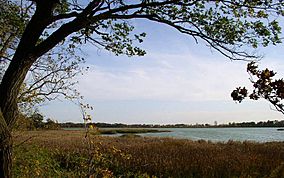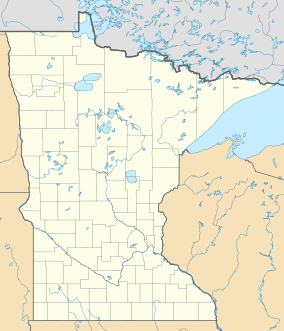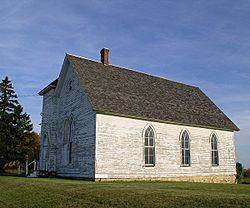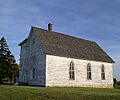Rice Lake State Park facts for kids
Rice Lake State Park is a fun state park in Minnesota, United States. It's located just east of a city called Owatonna. The park completely surrounds Rice Lake, which is a very important place for birds that are flying south for winter or north for summer.
The lake itself is about 750 acres (300 ha) big. That's like 568 football fields! It's also quite shallow, with an average depth of only 3 feet (1 m).
Contents
Discovering the Park's Natural History
How Rice Lake Was Formed
The ground under the park is made of limestone. This rock formed about 500 million years ago. It happened when tiny bits of plants and animals settled at the bottom of a shallow sea. This sea once covered a lot of the Midwest.
Later, about 400,000 years ago, huge sheets of ice called glaciers covered the area. These glaciers left behind a lot of dirt and rocks called till. As the glaciers melted, a big chunk of ice broke off. This ice block got stuck in the till. When it finally melted, it left a bowl-shaped hole. This hole is called a kettle, and it became Rice Lake.
About 10,000 years ago, another big glacier came through. This one, called the Wisconsin glaciation, went west of Rice Lake. The melting water from this glacier carved out stream beds in the older till.
The Zumbro and Straight Rivers
Rice Lake is where the South Branch of the Middle Fork of the Zumbro River begins. This stream used to be the only way water flowed out of the lake. It flowed to the east.
After the Wisconsin glacier, the land to the west became lower. This created a second way for water to leave the lake. This new path flows west into a different river system. It feeds the Straight River, which then joins the Cannon River.
Wildlife and Plants at Rice Lake
Long ago, Rice Lake might have been as deep as 55 feet (17 m). But over time, it has filled in a lot. This happened because of human activities and a process called eutrophication. This is when too many nutrients get into the water, causing plants to grow too much.
Today, the lake is surrounded by marshy plants. Because it's shallow and marshy, it's perfect for migrating waterfowl. Many different birds visit the park. You might see whistling swans, Canada geese, and snow geese. There are also diving ducks, western grebes, pied-billed grebes, and black terns.
The park's land has a forest with trees like maple, basswood, elm, and oak. There are also some open grassy areas. Before settlers arrived, the area was mostly oak savanna. This is a mix of grasslands and scattered oak trees. The east side of the lake had more trees. This was because the water helped protect it from wildfires coming from the prairie to the southwest.
Exploring the Park's Cultural History
Native Americans and Early Settlers
Wild rice grows naturally in Rice Lake. This is how the lake got its English name! Native Americans who lived here harvested the rice. It was a very important food source for them.
In 1851, the Treaty of Mendota opened up southern Minnesota for European settlers. By 1854, a small village called Rice Lake started on the northeast shore. It was on an important stagecoach route. People thought the village would grow big because a railroad was planned to go through it. But the railroad ended up being built farther south. So, the village of Rice Lake was soon abandoned.
One building from the old village still stands today. It's a Methodist church built in 1857. You can find it in the northeast part of the state park.
Changes to the Lake and Its Purpose
In the 1870s, people built dams and dikes on the lake's other outlets. They wanted more water to flow down the eastern outlet. This water was used to power a mill in Wasioja. However, the water level often got too low for the mill to work. The mill eventually closed and burned down in 1891.
Most of the water control structures stayed in place. This limited how much water could flow out of the lake. It also led to more eutrophication from farm runoff. Rice Lake became shallower as it filled with dead plants.
In the 1900s, Rice Lake became a popular spot for fun. Even though it was filling in, it was one of the few lakes in southeast Minnesota. Some groups, like the Izaak Walton League, owned land around the lake.
In 1961, a local newspaper editor named Dana Hinckley got people excited about creating a state park at Rice Lake. People in Owatonna were supportive. They had lost part of Kaplan Woods State Park to a new highway. Also, the local swimming pool was very crowded. People hoped the state would make Rice Lake deeper for boating and swimming. Because of all this support, the law to create Rice Lake State Park passed in 1963.
It took some time to buy all the land from private owners. Some owners didn't want to sell. But by 1967, new areas for visitors were ready. These were mostly on the land that used to belong to the Izaak Walton League.
The idea of making Rice Lake deeper for swimming didn't work out. The lake had too much mud, algae, and leeches. So, it wasn't great for swimming. But as the lake became less appealing for people, it became even better for waterfowl! Rice Lake State Park has now become a fantastic place for birdwatching.
Fun Things to Do at Rice Lake State Park
- Boating: There's a place to launch boats. Because the lake is shallow, canoes and kayaks are best. You can even rent canoes there!
- Camping:
- There are 42 drive-in campsites. Sixteen of these have electricity, and one is set up for people with disabilities.
- You can find 5 walk-in campsites.
- There are 4 cart-in campsites right on the lakeshore. You can use a cart to bring your gear.
- Five canoe-in campsites are on the south shore of the lake. You paddle to these!
- Two group camps are available for bigger groups, one for up to 40 people and another for up to 20.
- Trails: The park has 4 miles (6 km) of hiking trails. In winter, 3.5 miles (5.6 km) of these trails are groomed for cross-country skiing. Also, 1.5 miles (2.4 km) are ready for snowmobiling.
- Rice Lake is not the best for fishing or swimming. However, you can sometimes catch bullheads there.
Images for kids







